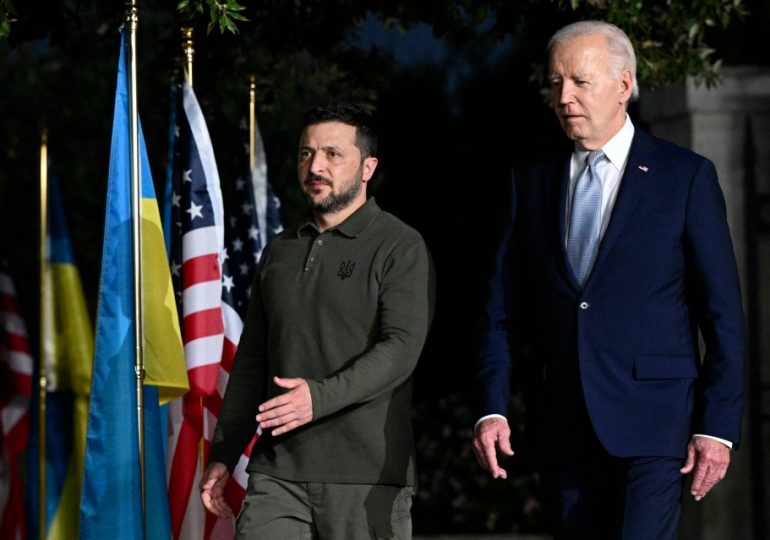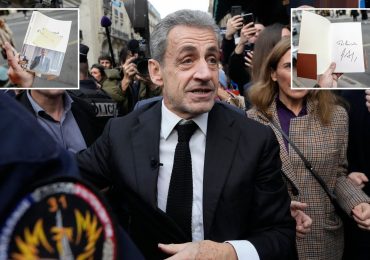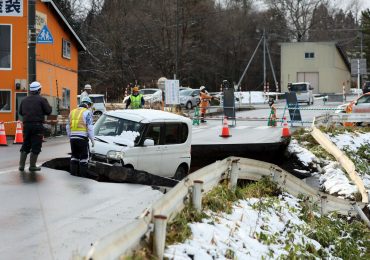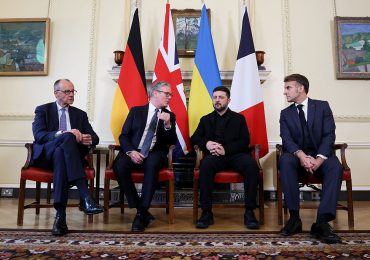A PAIR of Volodymr Zelensky’s top officials are set to hand the White House a list of targets in Russia they want to blast away with American missiles.
Head of Zelensky’s office Andriy Yermak and Defence Minister Rustem Umerov will hold crunch face-to-face talks with US officials in a bid to ease restrictions on launching strikes at Vlad’s territory.
Biden and Zelensky stroll side-by-side at a G7 meeting in JunePhoto by Mandel NGAN / AFP
A huge explosion at a Russian diesel facility after a devastating Ukrainian kamikaze drone strike
A Russian convoy left in tatters after it was struck in the Kursk region
They are set to jet into Washington DC, where they plan on providing a list of priority targets they say need to be struck to shift the war advantage back in Ukraine’s favour, according to reports.
Although the US has armed Ukraine with huge amounts of military aid to defend itself, it holds Kyiv back from firing its weapons into Russia to avert a broader escalation.
Ukraine has presented a list previously, but this one promises to be more tailored in a desperate effort to convince US President Joe Biden to lift restrictions, Politico reported.
The new bid comes after this week’s devastating Russian drone and missile attacks on Ukraine, killing at least seven and wounding dozens more.
The US has claimed loosening its leash on the Ukrainians wouldn’t make a huge difference because Russia has shifted key targets out of reach.
But Kyiv’s new list reportedly includes prime choices that American-supplied missiles are capable of striking.
Zelensky on Monday continued his calls for the US to let his nation loose, pointing out Russia was not bound by the same rules.
He said: “There should be no restrictions on the range of weapons for Ukraine, while terrorists have no such restrictions.
“Defenders of life should face no restrictions on weapons.”
US officials have poured cold water over the idea in public, with National Security Council spokesman John Kirby on Monday saying Washington hadn’t changed its policy.
He said: “This is not a new desire by President Zelensky by any stretch.
“But as I’ve said many, many times, we’ll keep the conversations with the Ukrainians going, but we’re going to keep them private.”
The US is continuing to beef-up Zelensky’s arsenal, with the Biden administration last week confirming a new £95m package bolstered by air defence missiles and artillery ammunition.
But the Ukrainians are believed to be ramping up efforts to loosen restrictions amid fears the US could pull back its aid if Donald Trump is elected back into office in November.
Trump in June called Zelensky “the greatest salesman of all time”.
He added: “He just left four days ago with $60 billion, and he gets home, and he announces that he needs another $60 billion. It never ends.
“I will have that settled prior to taking the White House as president-elect.”
Russian long-range missiles launchers destroyed in a Ukrainian strikex.com/@yarotrof
A determined Zelensky has continued calling for an easing of restrictionsPhoto by SERGEI CHUZAVKOV / AFP
Ukraine is hoping to shake hands with the US on a new game-changing dealPhoto by SAUL LOEB / AFP
Camouflaged Ukrainian soldiers prepare FPV drones in LuhanskDiego Herrera Carcedo/Anadolu via Getty Images
VLAD’S £1BILLION SPREE
The UK’s representative to the UN has said Russia’s huge bombardments on Ukraine this week cost the Kremlin more than £1bn.
Drones and missiles have pummelled into Ukraine in successive nights in what Zelensky said was “one of the biggest” strikes in the war.
James Kariuki told UN Security Council meeting: “The consequence of Putin’s miscalculation for the Russian people is increasingly evident.”
He also said there was mounting evidence that Russia was deliberately firing away at energy infrastructure relied on by innocent civilians.
KURSK OFFENSIVE CONTINUES
Kyiv’s troops have now captured 100 towns in the shock surge into Kursk that caught the Russians off-guard, it’s claimed.
Military chief Oleksandr Syrskyi also said his men had seized nearly 600 Russian soldiers.
The Ukrainians claim to now control 500 square miles of the region in the biggest takeover of Russian soil since the Nazis invaded in World War Two.
Russian reports earlier in the week said Ukraine attempted a bold secondary invasion into the neighbouring Belgorod region.
Moscow claimed to have the Belgorod border “under control” but admitted it was “difficult”.
Pro-Kremlin Telegram channel Shot said the Ukrainians were pushed back but kept firing at Russian checkpoints.
Russia’s slowed response to the Kursk invasion comes with Vlad said to be reluctant to pull many troops from Ukraine as he tries to dig deeper into the country’s east.
Why has the Ukrainian invasion of Russia been so successful?
By Georgie English, Foreign News Reporter
A DARING Ukrainian military push into Russia’s Kursk region has become the largest attack on the country since World War Two.
Kyiv’s forces have seized scores of villages, taken hundreds of prisoners and forced the evacuation of tens of thousands of civilians.
After more than a week of fighting, Russian troops are still struggling to drive out the invaders.
Why has Russian military been caught so unprepared?
A long undefended border
Russia’s regions of Kursk, Bryansk and Belgorod share a 720-mile border with Ukraine – including a 152-mile section in the Kursk region.
And it only had symbolic protection before Moscow invaded Ukraine in 2022.
It’s been reinforced since then with checkpoints on key roads and field fortifications in places – but not enough to repel a Ukrainian assault.
The most capable Russian units are fighting in eastern Ukraine, leaving the border vulnerable to attack.
Element of surprise
Ukrainian troops participating in the incursion were reportedly only told about their mission a day before it began.
The secrecy contrasted with last year’s counteroffensive – when Ukraine openly declared its goal of cutting the land corridor to annexed Crimea.
Ukraine ended up failing as troops trudged through Russian minefields and were pummelled by artillery and drones.
But in Kursk, Ukrainian troops didn’t face any of these obstacles.
Battle-hardened units easily overwhelmed Russian border guards and small infantry units made up of inexperienced conscripts.
The Ukrainians drove deep into the region in several directions – facing little resistance and sowing chaos and panic.
Russia’s slow response
The Russian military command initially relied on warplanes and choppers to try to stop the onslaught.
At least one Russian helicopter gunship was shot down and another was damaged.
Moscow began pulling in reinforcements, managing to slow Ukraine’s advances – but
But Putin has found another 30,000 troops to rush into Kursk, also appearing to call in reinforcements from Russia-friendly Belarus.
A worrying subplot to the fierce fighting in Kursk has been the fate of the region’s nuclear power plant.
The chief of the United Nations‘ nuclear agency this week flew in to inspect the site, which is located about 25 miles from the heat of battle.
International Atomic Energy Agency boss Rafael Grossi warned there is a “danger or possibility of a nuclear accident” that could cause “serious consequences”.
Heightening fears is the fact that the plant is not covered by a protective roof, meaning a strike on it could be devastating.
The Zaporizhzhia plant in Ukraine has also been the subject of nuclear concern since the early days of the war, with the Russians and Ukrainians both accusing each other of endangering it.
But those fears have not been realised amid desperate hopes of avoiding a Chernobyl-style disaster.
VLAD EYES KEY CITY
Despite the Ukrainian push into Kursk, the Kremlin is keeping focused on the city of Pokrovsk in the Donetsk region.
Pokrovsk is crucial for Ukrainian logistics, with a supply road running through it that connects the city with other military hubs.
Citizens are being evacuated as Kremlin forces draw closer.
Regional Governor Vadym Filashkin told Ukrainian TV 38,000 people and 1,900 children remained in the city that had a pre-war population of 80,000, Kyiv Independent reports.
Filashkin said it was now “dangerous and very difficult” with banks and other services shut down.
Search and rescue efforts after a Russian strike slammed into a hotelDnipropetrovsk Military Administration/Handout/Anadolu via Getty Images
A destroyed school building amid Russia’s relentless invasionGENYA SAVILOV/AFP via Getty Images
Fire crew work to put out a blaze in the Odesa regionOLEKSANDR GIMANOV/AFP via Getty Images
Leave a comment








